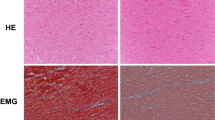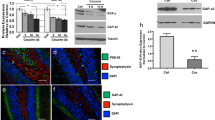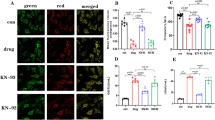Abstract
This study was designed to determine levels of NF-κB reporter gene activity and free radical generation in cultured striated myocytes (H9C2 cells) exposed to cocaine or morphine in the presence of free radical scavengers. Cells were transiently transfected with a NF-κB reporter gene and changes in luciferase activity were detected, by bioluminescence. Using confocal microscopy and 2′,7′-dichlorofluorescin diacetate, cocaine-induced or morphine-induced free radicals were quantified in H9C2 cells. Cocaine and morphine (0–1×10−2 M) were tested separately. Cocaine but not morphine significantly activated Nf-κB reporter gene, activity in H9C2 cells. Overexpression of IκB inhibited NF-κB reporter activity at low (1×10−4 M) but not high (1×10−2 M) cocaine concentrations. Free radicals were generated in H9C2 cells stimulated with cocaine but not with morphine. The production of free radicals and NF-κB reporter gene activity could be blocked with N-acetylcysteine, glutathione, and to a lesser extent, lipoic acid. The results suggest that cocaine induces free radical production, which leads to the activation of NF-κB signal transduction and possible inflammatory responses.
Similar content being viewed by others

References
Jaspers, I., Chen, L. C., and Flescher, E. (1998). Induction of interleukin-8 by ozone is mediated by tyrosine kinase and protein kinase A, but not by protein kinase C. J. Cell. Physiol. 177:313–323.
Ogata, N., Yamamoto, H., Kugiyama, K., Yasue, H., and Miyamoto, E. (2000). Involvement of protein kinase C in superoxide anion-induced activation of nuclear factor-kappa B in human endothelial cells. Cardiovasc. Res. 45:513–521.
Sen, R. and Baltimore, D. (1986). Multiple nuclear, factors interact with the immunoglobulin enhancer sequences. Cell 46:705–716.
Kaltschmidt, C., Kaltschmidt, B., Neumann, H., Wekerle, H., and Baeuerle, P.A. (1994). Constitutive NF-kappa B activity in neurons. Mol. Cell. Biol. 14:3981–3992.
Lawrence, R., Chang, L.J., Siebenlist, U., Bressler, P., and Sonenshein, G.E. (1994). Vascular smooth muscle cells express a constitutive NF-kappa B-like activity. J. Biol. Chem. 269:28913–28918.
Grimm, S. and Baeuerle, P.A. (1993). The inducible transcription factor NF-κB: Structure-function relationship of its protein subunits. J. Biochem. 290:297–308.
Baeuerle, P.A. and Baltimore, D. (1988). I kappa B: a specific inhibitor of the NF-kappa B transcription factor. Science 242:540–546.
Baeuerle, P.A. and Baltimore, D. (1988). Activation of DNA-binding activity in an apparently cytoplasmic precursor of the NF-B transcription factor. Cell 53:211–217.
Henkel, T., Machleidt, T., Alkalay, I., Kronke, M., Ben-Neriah, Y., and Baeuerle, P.A. (1993). Rapid proteolysis of I kappa B-alpha is necessary for activation of transcription factor NF-kappa B. Nature 365:182–185.
Palombella, V.J., Rando, O.J., Goldberg, A.L., and Maniatis, T. (1994). The ubiquitin-proteasome pathway is required for processing the NF-ekaoppa B1 precursor protein and the activation of NF-kappa B. Cell 78:773–785.
Traenckner, E.B., Pahl, H.L., Henkel, T., Schmidt, K.N., Wilk, S., and Baeuerle, P.A. (1995). Phosphorylation of human I kappa B-alpha on serines 32 and 36 controls I kappa B-alpha proteolysis and NF-kappa B activation in response to diverse stimuli. J. EMBO 14:2876–2883.
Thompson, J.E., Phillips, R.J., Erdjument-Bromage, H., Tempst, P., and Ghosh, S. (1995). I kappa B-beta regulates the persistent response in a biphasoc activation of NF-kappa B. Cell 80:573–582.
Grilli, M., Chiu, J.J., and Lenardo, M.J. (1993). NF-kappa B and Rel: participants in a multiform transcriptional regulatory system. Int. Rev. Cytol. 143:1–62.
Siebenlist, U., Franzoso, G., and Brown, K. (1994). Structure, regulation and function of NF-kappa B. Annu. Rev. Cell. Biol. 10:405–455.
Baeuerle, P.A. and Baltimore, D. (1996). NF-kappa B: ten years after. Cell 87:13–20.
Landry, D.B., Couper, L.L., Bryant, S.R., and Lindner., V. (1997). Activation of the NF-kappa B and I kappa B system in smooth muscle cells after rat arterial injury. Induction of vascular cel adhesion molecule-1 and, monocyte chemoattractant protein-1. Am. J. Pathol. 151:1085–1095.
Brach, M.A., Hass, R., Sherman, M.L., Gunji, H., Weichselbaum, R., and Kufe, D. (1991). Ionizing radiation induces expression and binding activity of the nuclear factor kappa B. J. Clin. Invest. 88:691–695.
Schreck, R., Rieber, P., and Baeuerle, P.A. (1991). Reactive oxygen intermediates as a pparently widely used messengers in the activation of the NF-kappa B transcription factor and HIV-1. J EMBO 10:2247–2258.
Peng, M., Huang, L., Xie, Z.J., Huang, W.H., and Askari, A. (1995). Oxidant-induced activations of nuclear factor-kappa B and activator protein-1 in cardiac myocytes. Cell. Mol. Biol. Res. 41:189–197.
Hattori, Y., Akimoto, K., Murakami, Y., and Kasai K. (1997). Pyrrolidine dithio carbamate inhibits cytokine-induced VCAM-1 gene expression in rat cardiac myocytes. Mol. Cell. Biochem. 177:177–181.
Kacimi, R., Karliner, J.S., Koudssi, F., and Long, C.S. (1998). Expression and regulation of adhesion molecules in cardiac cells by cytokines: response to acute hypoxia. Circ. Res. 82:576–586.
Li, C., Browder, W. and Kao, R.L. (1999). Early activation of transcription factor NF-kappa B during ischemia in perfused rat heart. Am. J. Physiol. 276:H543-H552.
Chandrasekar, B., Smith, J.B., and Freeman, G.L. (2001). Ischemia-reperfusion of rat myocardium activates nuclear factor-KappaB and induces neutrophil infiltration via lipopolysaccharide-induced CXC chemokine. Circulation 103: 2296–2302.
Altavilla, D., Deodato, B., Campo, G.M., Arlotta, M., Miano, M., Squadrito, G., et al. (2000). IRFI 042, a novel dual vitamin E-like antioxidant, inhibits activation of nuclear factor-kappaB and reduces the inflammatory response in myocardial ischemia-reperfusion injury. Cardiovasc. Res. 47:515–528.
Wong, S.C., Fukuchi, M., Melnyk, P., Rodger, I., and Giaid, A. (1998). Induction of cyclooxygenase-2 and activation of nuclear factor-kappaB in myocardium of patients with congestive heart failure. Circulation 98:100–103.
Hargrave, B.Y. and Lattanzio, F. (2002). Cocaine activates renin angiotensin system in pregnant rabbits and alters the response to ischemia. Cardiovasc. Toxicol. 2:91–97.
Yeh, S.Y., Gorodetzky, C.W., and Krebs, H.A. (1977). Isolation and identification of morphine 3- and 6-glucuronides, morphine 3,6-diglucuronide, morphine 3 ethereal sulfate, normorphine and normorphine 6-glucuronide as morphine metabolites in humans. J. Pharmacol. Sci. 66:1288–1293.
Oliveira, M.T., Rego, A.C., Morgadinho, M.T. Macedo, T.R., and Oliveira, C.R. (2002). Toxic effects of opioid and stimulant drugs on undifferentiated PC12 cells. Ann. N.Y. Acad. Sci. 965:487–496.
Yu, R.C.T., Lee, T.C., Wang, T.C., and Li, J.H. (1999). Genetic toxicity of cocaine. Carcinogenesis 20:1193–1199.
Cohen, M.V., Yang, X.M., Liu, G.S., Heusch, G., and Downey, J.M. (2001). Acetylcholine, bradykinin, opioids and phenylephrine, but not adenosine, trigger preconditioning by generating free radicals and opening mitochondrial Katp channels. Circ. Res. 89:273–278.
McPherson, B.C. and Yao, Z. (2001). Signal transduction of opioid-induced cardioprotection in ischemia-perfusion. Anesthesiology 94:1082–1088.
Fantel, A. and Person, R.E. (2002). Involvement of mitochondria and other free radical sources in normal and abnormal fetal development. Ann. N. Y. Acad. Sci. 959:424–433.
Castelli, M.C., Venturini, L., and Sparber, S.B. (2001). Cocaine and salicylate; documentation of hydroxyl radical formation in hearts and brains of 18-day-old chick embryos and unexpected interactive toxicity. Psychopharmacology 156:23–31.
Yang, Y., Xiao, H., Ke, Q., Cai, J., Xiao, Y.F., and Morgan, J.P. (2002). Enhancement of nitric oxide production by methylergonovine in cultured neonatal rat cardiomyocytes. Br. J. Pharmacol. 135:188–196.
Regnier, C.H., Song, H.Y., Gao, X., Goeddel, D.V., Cao, Z., and Rothe, M. (1997). Identification and characterization of an IkappaB kinase. Cell. 90:373–383.
Author information
Authors and Affiliations
Rights and permissions
About this article
Cite this article
Hargrave, B.Y., Tiangco, D.A., Lattanzio, F.A. et al. Cocaine, not morphine, causes the generation of reactive oxygen species and activation of NF-κB in transiently cotransfected heart cells. Cardiovasc Toxicol 3, 141–151 (2003). https://doi.org/10.1385/CT:3:2:141
Received:
Revised:
Accepted:
Issue Date:
DOI: https://doi.org/10.1385/CT:3:2:141



